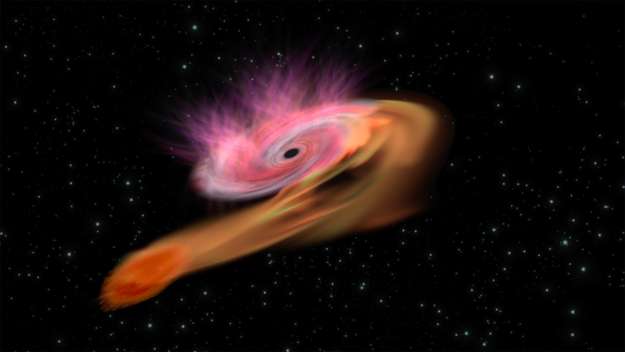March 9, 2017 report
Two new tidal disruption events discovered

In two recently published scientific papers, an international team of astronomers has presented the detection of two new tidal disruption events (TDEs). Using the Palomar Observatory located near San Diego, California, the researchers discovered flares of radiation which turned out to be TDEs. Their findings were described in papers published online March 2 and 3 on the arXiv pre-print server.
TDEs are astronomical phenomena which occur when a star passes close enough to a supermassive black hole and is pulled apart by the black hole's tidal forces, causing the process of disruption. Such tidally disrupted stellar debris starts raining down on the black hole and radiation emerges from the innermost region of accreting debris, which is an indicator of the presence of a TDE.
For astronomers and astrophysicists, TDEs are potentially important probes of strong gravity and accretion physics, providing answers about the formation and evolution of supermassive black holes.
The first TDE identified in the 1990s took the form of luminous soft X-ray outbursts in quiescent galaxies from the ROSAT survey. More recent TDE discoveries were made by surveys like the intermediate Palomar Transient Factory (iPTF), which utilizes the 1.2-meter Samuel Oschin Telescope at Palomar Observatory. Now, a team of astronomers reports another detection of TDEs from the iPTF survey.
The newly found TDEs were spotted on May 29 and Aug. 29, 2016 and designated iPTF16axa and iPTF16fnl respectively. A series of follow-up observations using NASA's Swift space observatory and ground-based telescopes was also conducted to gain insights into the evolution of these two events.
The researchers found that iPTF16axa was detected 49 rest-frame days after disruption. They discovered that its light curve shows no color evolution with time and has a constant temperature of about 30,000 K. They also found that this TDE is hosted by a Sloan Digital Sky Survey (SDSS) galaxy with an estimated black hole mass of approximately 40 million solar masses – one of the highest black hole masses among TDE hosts known to date.
The data provided by Swift allowed the team to exclude the possibility that the detected flare of radiation could be caused by a variable active galactic nucleus (AGN) and confirmed that it originated from a TDE.
"Both Swift UVOT observations and the follow up spectra of iPTF16axa are consistent with the object being a TDE rather than a supernova or a variable AGN," the paper reads.
Moreover, the research indicates that the massive black hole and the short rise time suggest that general relativity effects might play an important role in this event.
In contrary to iPTF16axa, iPTF16fnl is hosted by a galaxy (designated Markarian 950) with a much less massive black hole – about two million solar masses. It is the lowest black hole mass in TDE hosts among the optical sample of TDEs. The team also noted that iPTF16fnl shows very strong emission in ultraviolet wavelengths, with a temperature of about 19,000 K. They added that this TDE is very unusual when compared to other such events.
"iPTF16fnl is remarkable in three ways: it is the nearest well studied TDE (66.6 Mpc), and it has one of the shortest exponential decay timescales (about 15 days) and one of the lowest peak luminosities," the researchers wrote.
More information:
arxiv.org/pdf/1703.00965.pdf
arxiv.org/pdf/1703.01299.pdf
© 2017 Phys.org





















